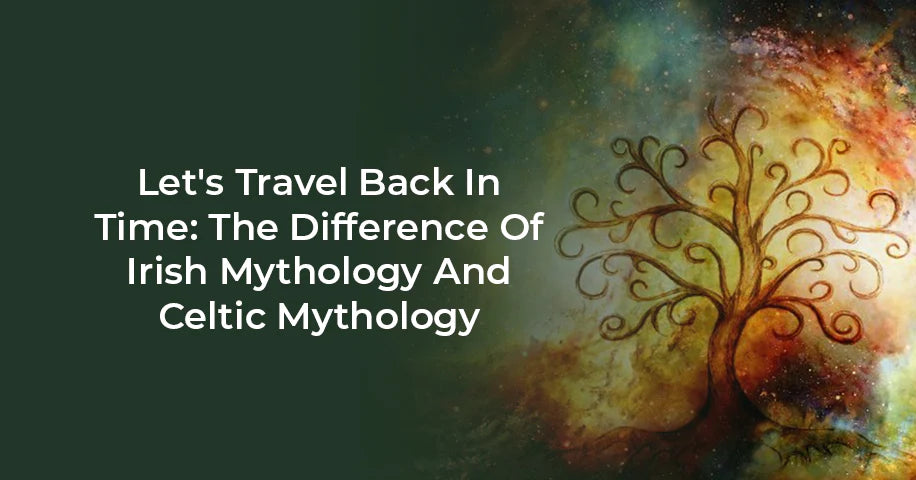Let's Travel Back In Time: The Difference Of Irish Mythology And Celtic Mythology

Are Irish and Celtic mythologies the same, or do you only hear people use the words together? The majority of people that take a glimpse of the two concepts may interchange them or use them as one factual reference. Then again, we must understand that these are two different concepts and forms of literature derived from various scriptures from different eras.

Irish myths and Celtic folklore are inextricably connected. While they're not precisely synonyms, Irish mythology is a branch of Celtic mythology, much as Catholicism is a branch of Christianity.
And it wasn't only the Irish who received these Celtic gods; the Scottish, Cornish, Isle, Rennes, and Wales ancestors of the Gaulish Celtics also did, since they, like the Irish, lived on the western outskirts of Europe, far from Roman influence.
Celtic Mythology (Explained)
Ancient Celtic myths concern deities, warriors, and the universe's beginnings. These legends were part of an old Celtic polytheistic religion that spanned most of Western Europe and ended up as far eastward as modern-day Turkey. This religion expanded with the Celts.
The Romans brought their fight with the Celts to many Celtic countries, including France, Spain, and Britain, all of which had a culture of Celtic mythology. Still, the mythology only found its way into writing once the Romans came. After the Romanization of Celtic territories, Celtic mythology was declared extinct, with very little remaining in its original form. On the other hand, in Western Europe, particularly Ireland, the Celtic mythology continued to develop and thrive.
An Irish legend about a shape-shifter like Tuan Mac Carell that demonstrates both Irish and more expansive Celtic views of rebirth also shows us how much ancient Irish mythology emphasizes that individuals may have a choice in their appearance. And in this following example, we see still another religious lineage, beginning with the Gaulish Celts and extending to their Goidelic-speaking successors.
One of the earliest Europeans to believe in immortality was the Celtic people. From the religious philosophy, their people thought that when someone died, they were not gone forever but that their existence transitioned to the realm of the dead, where they still could enjoy their favorite pastimes and necessities.


Celtic Mythology (Explained)
Ancient Celtic myths concern deities, warriors, and the universe's beginnings. These legends were part of an old Celtic polytheistic religion that spanned most of Western Europe and ended up as far eastward as modern-day Turkey. This religion expanded with the Celts.
The Romans brought their fight with the Celts to many Celtic countries, including France, Spain, and Britain, all of which had a culture of Celtic mythology. Still, the mythology only found its way into writing once the Romans came. After the Romanization of Celtic territories, Celtic mythology was declared extinct, with very little remaining in its original form. On the other hand, in Western Europe, particularly Ireland, the Celtic mythology continued to develop and thrive.
Irish Mythology (Explained)
Irish myth is the most intact version of Celtic mythology since it was built by ancient Gaels, who came to Ireland about 500 BCE and had a Gaeilge (Goidelic-speaking Celts) language and an epic storytelling tradition. (For perspective, Ireland's earliest settlers landed about 6,500 BCE, give or take.)
Once the Gaels arrived in Ireland, they discovered ancient stone monuments (such as dolmens and cairns) and burial mounds (such as tumuli). They were inspired to develop new tales and religious beliefs to add to their Celtic paganism. One interpretation of burial mounds was that they lead to the Celtic Parallel world: the gods' home.
Scholars have broken Irish myth into four cycles: chronological periods, which they have differentiated by date. And the fact that Irish gods can be found in every process, except for the early one, which was created using myth, means that it needs to be corrected to label the first phase, the Mythological Cycle, as a false narrative.
Before the implementation of the 4 Cycles, traditional Irish mythologists classified stories as either "principal tales" or "sub-tales" (minor tales). Prim and fo-scéil narratives include many examples of fight scenes, journeys, disasters, adventures, cattle raids, wars, affairs, elopements, discoveries, devastation, destruction, sieges, feasts, and killings.

Thus, Christian missionaries reached Ireland (between 400 and 450 CE), and Irish myth and Celtic mythology were almost entirely spoken, with few documents existing. While Christian monks preserved Irish mythology, this was challenging when attempting to write their texts since they demoted many Irish deities and heroes to evil spirits or ordinary humans.
In the end, mythological eras have contributed to Celtic and Irish practices in their respective ways. After going through both generic explanations uncovered of their specific origins, we can also clearly see how they are intertwined through beliefs yet different in practice.
Our history and ancestry are filled with so much depth and meaning. No wonder the designs and emblems that are prominent in the past are still with us through different forms and historical landscapes.
Wear a piece of Ireland today and embrace your Irish and Celtic background through handcrafted jewellery. Visit our store at Celtic Knot Jewellery. to get yours TODAY!




